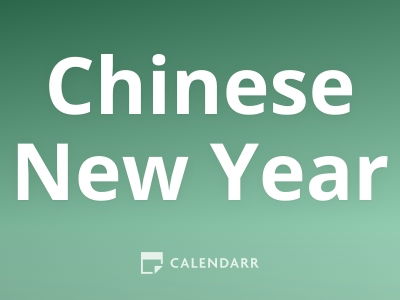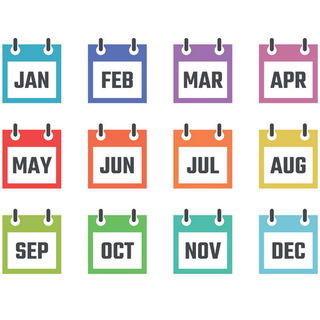- Calendar
- Calendar 2025
- February
- Chinese New Year
Chinese New Year
We are currently in the Year of the Dragon.
Chinese New Year, also known as Lunar New Year and Spring Festival, is celebrated in the United States by its large Chinese community. It marks the beginning of the new year in the Chinese lunar calendar, and it falls on the first day of the month of the calendar, which is marked by the new moon that usually appears between January 21 and February 20. Chinese New Year celebrations last for 15 days, also marking the beginning of Spring and the end of Winter in China.
The Chinese calendar follows the phases of the moon, and it is in its fifth Millenium, making it one of the oldest in history. In Chinese culture, every year is represented by a different animal of Chinese astrology. There are twelve different animals, which are cycled every year. The animals are Rat, Ox, Tiger, Rabbit, Dragon, Snake, Horse, Goat, Monkey, Rooster, Dog, and Pig. Millenium, making it one of the oldest in history. In Chinese culture, every year is represented by a different animal of Chinese astrology. There are twelve different animals, which are cycled every year. The animals are Rat, Ox, Tiger, Rabbit, Dragon, Snake, Horse, Goat, Monkey, Rooster, Dog, and Pig.
Background
Chinese New Year has been celebrated for over four thousand years, and originally it was a day to commemorate the end of Winter and the beginning of Spring, thus it is associated with the agricultural cycle. In Chinese culture, the first day of the year means a new dawn and the hope of a prosperous harvest for the year ahead.
To celebrate the new year, the Chinese dress in red, decorate their houses in the same color, and set off fireworks and firecrackers. This is because legend has it that thousands of years ago there was a monster named Nian, a lion-headed bull, who would attack villagers on the first day of the year. It is said that Nian was scared of bright lights, loud sounds, and the color red, so the villagers used these to scare the monster away. This became a Chinese New Year tradition that has lasted until today. Nian, a lion-headed bull, who would attack villagers on the first day of the year. It is said that Nian was scared of bright lights, loud sounds, and the color red, so the villagers used these to scare the monster away. This became a Chinese New Year tradition that has lasted until today.
The customs and traditions of the Chinese New Year all have the purpose of renewal, to be out with the old and in with the new, in preparation for good luck, happiness and prosperity in the new year. It is a time to get together with friends and family, share big feasts of delicious food, wishes of good luck, and exchange of gifts.
Chinese New Year Customs and Traditions
The Chinese New Year is all about starting things anew. So, in the week leading up to the festival, people do a thorough cleaning of their home to get rid of bad luck.
This should all be done before New Year's Day though, as showering is not allowed on the day! At the same time, it is also not allowed to sweep or throw out garbage until the 5th day of the festival. This is so people don't wash out the good luck!
There are also a few no-no's during the Chinese New Year, which everyone should abstain from doing for the 15 days. It is taboo to get a haircut, argue, swear, and say unlucky words, using scissors or knives, and breaking things.
Traditionally, people are meant to eat dumplings for every day of the Chinese New Year celebrations, however, that practice has died down. The New Year's Eve meal is still the most important of the year for Chinese families, and throughout the 15 days, it is common to go to different relatives' houses to share food. These feasts are abundant and delicious, with a variety of traditional Chinese food and special wine.
There are different practices and celebrations on each of the festival's 15 days. For example, it is believed that the Gods of Wealth come down on the 5th day of the New Year, so people pray to them and set off firecrackers in their honor. The 15th and final day of the New Year festival is known as the Festival of Lanterns, so people hang paper lanterns on the streets and their homes, and carry them on parades.
There are also different symbols used during the Chinese New Year, each with its own meaning:
- It is common for Red Envelopes to be filled with money and given to children or adults with no job. Usually, these red envelopes are gifted by established married couples to their single friends, or from elders to the children. Their purpose is to transfer the fortune and luck from the givers to the gifted.
- The Dragon is a common symbol in Chinese culture, as people believe that the Chinese are descended from the creature. During the festivities, there are dancing dragon performances, as the creature is believed to bring good luck, good fortune, and prosperity.
- Flowers, tangerines, and oranges are displayed as a sign of good luck and wealth.
- Decorations are Red , made of paper and shaped like a diamond, and usually have writings on them referring to luck and prosperity.
How to Celebrate the Chinese New Year
In the United States, the Chinese communities have brought their customs and traditions, and proudly demonstrate them during the Chinese New Year. As it is common, these celebrations last for days.
There are colorful parades, filled with costumes, floats, and firecrackers. During these parades, you can witness the famous lion and dragon dances. Firework displays are also impressive, and a long-lasting tradition of Chinese culture.
In cities where there is a vibrant Chinatown, there are fun runs, walks, food markets and street fairs, and pageants that display the Chinese culture.
If you enjoyed reading this, you might like to read these next:

Other Celebrations
-
Jan 01 WedNew Year's Day Holiday
-
Apr 20 SunChinese Language Day
-
Apr 25 Fri
-
Dec 31 Wed
-
Jan 03 SatMahayana New Year
-
Feb 17 TueLunar New Year











